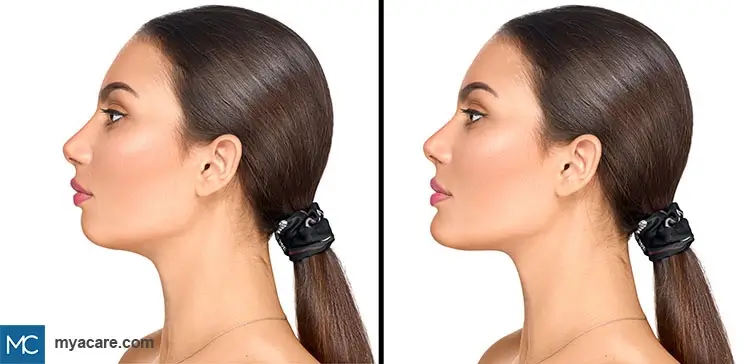Chin Fillers vs. Chin Implants

Two vital components of aesthetic appeal are symmetry and balance.
That applies to all physical features of the body. That's a rule, and the chin is no exception.
Harmony between the nose, cheeks, eyes, lips, forehead, jawline and chin is can create a balanced profile for an individual.
Chin and Beauty
In facial structure, the aesthetic role of the chin is to create a contrast between the face and the neck. A well-defined chin is a focal point that balances other facial features.
A well shaped chin can improve the facial profile. For example, when the chin is too small - the nose appears bigger.
Luckily, modern medicine offers several quality solutions for chin improvement. The two most popular ones are chin fillers and chin implants. The goal of both procedures is to add volume to the chin, but that’s where most similarities end.

This article aims to help patients understand how these treatments can help them. We’ll also elaborate on the pros, cons, and potential risks.
So, if you are thinking a chin implant or filler, but you're unsure about which procedure to pick, read on.
Overview
It is difficult to say which of the two procedures is better. That's because each individual has specific desires, needs, and limitations. For one patient, fillers may be a more suitable option. For another, it may be the opposite.
The vital difference between fillers and implants is in their invasiveness. Chin fillers are minimally invasive injectables, while chin implants are a surgical procedure.
There are other differences too. Most fillers produce non-permanent results, while implants are permanent. The costs of the two also differ, and so on.
When planning a chin augmentation procedure, there are many factors to consider. The best way is to understand all the pros and cons. So, let's take a more detailed look at both procedures.
Chin Implant Surgery
Chin implant procedure is a type of plastic surgery. The goal of the procedure is to add volume and restructure the chin. In some cases, a mix of chin augmentation, facial liposuction, and rhinoplasty is necessary.
Additionally, the procedure can help with skin deformities in the chin area and improve defects of various origins. However, aesthetic indications, such as a small chin, are most common.
Chin augmentation surgery, using implants, lasts a few hours. It requires local or general anesthesia, with the incision under the chin or inside the mouth.
The common materials for implants include:
- Silicone
- AllloDerm (Acellular Dermal Matrix)
- Gore-Tex
- Medpor
Common side effects include:
- Bruising,
- Swelling, and
- Discomfort.
These occur due to incision-induced trauma. Bandages and stitches are necessary after surgery. Their removal usually takes place seven to ten days after the procedure.
The recovery process is not very complex. However, some downtime is necessary. Chewing is a challenge for the first few days of recovery. So, doctors will likely recommend a liquid diet for two or three days, followed by a soft diet for the same period.
It is essential to avoid sleeping on the chin, putting any pressure on the area, or exercising.
The results of chin augmentation are highly-satisfying and permanent. The procedure causes radical changes in facial proportion. However, it may take up to three months for the swelling to subside completely.
Pros
- Chin augmentation balances facial features and improves symmetry and facial profile.
- It is a one-time procedure with permanent results.
- It is reversible (you can take the implants out).
- Implants can also smooth out other chin irregularities (not only the size).
- A safe and non-complicated surgical procedure
Cons
- Bruising, swelling, and discomfort after the procedure are common.
- The chin often becomes temporarily numb (for several weeks).
- The maximum effect of the surgery is not visible until two to three months after the procedure.
- There is downtime. Complications, such as infections, are possible.
- In comparison to chin fillers, the cost is significantly higher.
Chin Fillers Procedure
Fillers are a non-surgical option for mild to moderate chin re-shaping and augmentation. The range of potential improvements is much smaller than with chin implants. However, chin fillers are cheaper, do not require any downtime, and the results are instantly visible.
Today, most fillers are hyaluronic acid fillers. Their effect lasts between six to twelve months. There are also other semi-permanent options, such as PMMA. The polymethyl methacrylate fillers are a longer-lasting solution. However, they carry a risk of complications.
The chin fillers procedure usually lasts between fifteen to forty-five minutes. There is no need for sedation. Topical anesthetics do the job just fine.
The cost of one treatment is significantly smaller compared to chin implant surgery. The maintenance costs, however, may amount to much more over time.
The temporary effect has a good side too. If you do not like the results, you will not need a revision procedure. They will wear off after some time, leaving you free to pick a different treatment.
Pros
- No need for incisions, surgery, or downtime
- Low risk of complications
- No need for local or general anesthesia (only topical)
- The results are instantly visible.
- Safe, effective, and low-cost solution
Cons
- Regular maintenance treatments are necessary to maintain the effects.
- Long-term higher cost
- Only mild to moderate improvements are possible (no radical changes).
The Bottom Line
Dermal fillers are a cost-effective way of testing the effects of chin augmentation on your physical appearance. If you are unsure about surgery, the fillers can give you a taste of the possibilities, which will help you understand if a more drastic improvement is necessary. Once, if ever, you are ready for permanent changes, chin implants are the way to go.
To search for the best Plastic & Cosmetic Surgery healthcare providers in Croatia, Germany, Greece, India, Malaysia, Singapore, Slovakia, Spain, Thailand, Turkey, Ukraine, the UAE, the UK and the USA, please use the Mya Care search engine.

Dr. Rosmy Barrios is an aesthetic medicine specialist with international work experience. She earned her physician diploma at the Universidad Del Norte’s School of Medicine in Barranquilla, Colombia, and her specialty at John F. Kennedy University in Buenos Aires, Argentina. Dr. Barrios is a member of the Pan-American Aesthetic Medicine Association (PASAM) and the Union Internationale de Médecine Esthétique (UIME). She is an expert health writer with keen interests in aesthetic medicine, regenerative aesthetics, anti-aging, fitness, and nutrition. Currently, Dr. Barrios heads the Regenerative Aesthetics department at a renowned Internal Medicine clinic based in Belgrade, Serbia.
References:
Featured Blogs



